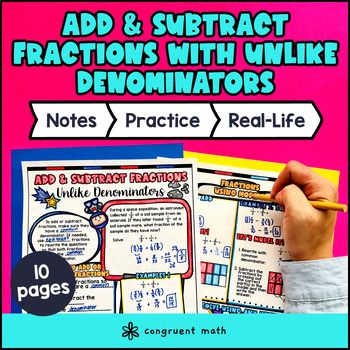Want more ideas and freebies?
Get my free resource library with digital & print activities—plus tips over email.
Join for Free Resources →
$4.25
Ever wondered how to teach adding and subtracting fractions with unlike denominators in an engaging way to your 5th or 6th-grade students?
In this lesson plan, students will learn about fraction addition and subtraction and their real-life applications. Through artistic, interactive guided notes, check for understanding, a practice activity that includes a doodle & color by number worksheet, and a maze worksheet, students will gain a comprehensive understanding of adding and subtracting fractions with unlike denominators.
The lesson culminates with a real-life example that explores how this math skill can be applied in practical situations. Students will read and write about real-life uses of adding and subtracting fractions.

$4.25
After this lesson, students will be able to:
Before this lesson, students should be familiar with:
As a hook, ask students why it is important to know how to add and subtract fractions with unlike denominators in real-life situations.
Use the first page of the guided notes to introduce the concept of adding and subtracting fractions with unlike denominators. Walk through the steps of finding a common denominator, adding or subtracting the numerators, and simplifying the fraction. Emphasize the importance of finding a common denominator to make the fractions compatible.
Use the second page of the guided notes to introduce how to use visual models to solve fractions addition and subtracting with unlike denominators. Walk through the steps of finding a common denominator, subtracting the numerators, and simplifying the fraction.
Based on student responses, reteach concepts that students need extra help with. If your class has a wide range of proficiency levels, you can pull out students for reteaching, and have more advanced students begin work on the practice exercises.
Have students practice adding and subtracting fractions with unlike denominators using the practice worksheet provided in the resource in the first two pages of the guided notes. Walk around the classroom to answer any questions students may have.
Fast finishers can continue practicing with the maze activities (page 3) or color by number (page 4) included in the resource. You can assign these activities as extra practice or as homework for the remainder of the class.
Use the last page of the guided notes to bring the class back together, and introduce the concept of real-life application of adding and subtracting fractions with unlike denominators. Explain to the students that understanding how to add and subtract fractions is important in many real-life situations.
Some examples of real-life applications of adding and subtracting fractions include:
Discuss these examples with the students and encourage them to brainstorm other situations where adding and subtracting fractions might be useful in their daily lives. This discussion will help them see the relevance and practical application of the skills they are learning.
If you’re looking for digital practice for adding and subtracting fractions with unlike denominators, try my Pixel Art activities in Google Sheets. Every answer is automatically checked, and correct answers unlock parts of a mystery picture. It’s incredibly fun, and a powerful tool for differentiation.
Here are some activities to explore:
A fun, no-prep way to practice adding and subtracting fractions with unlike denominators is Doodle Math — they’re a fresh take on color by number or color by code. It includes multiple levels of practice, perfect for a review day or sub plan.
Here are some activities to try:
Unlike denominators are denominators that are different from each other in a fraction. In other words, when the numbers at the bottom of two or more fractions are not the same, they have unlike denominators.
Examples of unlike denominators:
To add fractions with unlike denominators, you need to find a common denominator. Once you have a common denominator, you can add the numerators together and keep the common denominator.
Steps to add fractions with unlike denominators:
Subtracting fractions with unlike denominators is similar to adding fractions with unlike denominators. You need to find a common denominator first, and then subtract the numerators while keeping the common denominator.
Steps to subtract fractions with unlike denominators:
A common denominator is a number that is divisible by all the denominators in a set of fractions. It is used to make the fractions have the same denominator so that they can be added or subtracted easily.
Example of finding a common denominator: Let's say we have the fractions 1/2 and 3/4. The common denominator for these fractions is 4 because it is divisible by both 2 and 4.
To find the common denominator for fractions, you can use the least common multiple (LCM) of the denominators. The LCM is the smallest multiple that both denominators have in common.
Steps to find the common denominator for fractions:
Yes, fractions with unlike denominators can be simplified. However, simplifying fractions is not necessary when adding or subtracting fractions with unlike denominators. Simplifying is done to express the fraction in its simplest form.
Example of simplifying a fraction: Let's say we have the fraction 4/8. It can be simplified by dividing both the numerator and denominator by their greatest common factor (GCF), which in this case is 4. So, 4/8 simplifies to 1/2.
You can practice adding and subtracting fractions with unlike denominators by using worksheets, online math activities, or interactive games. These resources provide practice problems and allow you to check your answers.
Available resources for practicing adding and subtracting fractions with unlike denominators:
Yes, there are many real-life applications for adding and subtracting fractions with unlike denominators. Some examples include:
Adding and subtracting fractions with unlike denominators is a valuable skill that can help in various real-life situations where fractions are involved.
Get my free resource library with digital & print activities—plus tips over email.
Join for Free Resources →